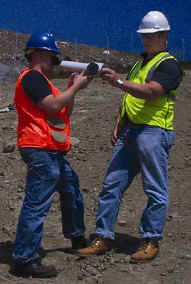Tech Environmental e-Newsletter LANDFILL ODOR GUIDELINES
A number of public comments to the draft guideline have been incorporated into the final guideline. Tech Environmental was particularly concerned that the draft document grouped odor and hydrogen sulfide together in a single Action Table, so that a single odor complaint could, in essence, trigger one or all of the "Action(s) to be Taken by Landfill Operators." In other words, any single odor complaint could have immediately subjected a landfill to extensive odor monitoring, regardless of whether it was part of a pattern or an isolated incident. In the final guideline, there are two tables: one for total odor and one for hydrogen sulfide.
Another significant improvement to the final document is the elimination of the "Fenceline Monitoring Program" Action Item. Although landfill operators may not be thrilled to learn that continuous monitoring is still an Action Item in Table 2, the coverage and locations of any monitoring program will not be arbitrarily assigned to the fenceline and can be made on a site-by-site basis to best address site-specific odor concerns. The hydrogen sulfide Action Level thresholds remain unchanged from the draft: 15 ppb and 30 ppb, averaged over 8-hour (rolling average) or one-hour periods, respectively. It is important to note that the document acknowledges these levels are purposely set above the odor threshold, in order to define an odor nuisance and to alert individuals of increasing concentrations of hydrogen sulfide. This document is not intended to be a public health document, nor does it establish public health thresholds of concern, but it does provide a safety net for measurable data above the odor threshold to be reported to public health officials so they can monitor potential health concerns. Taken as a whole, the new Massachusetts landfill odor guidelines have improved significantly from their draft form. Tech Environmental will continue to follow the development of similar guidelines across the Northeast, offering constructive comments when possible and keeping our clients apprised of the latest news.
SUBSCRIBE TO THIS NEWSLETTER If you have been forwarded this email and wish to receive it regularly,
CONTACT US Waltham, Massachusetts 02451 ph. 781-890-2220 fax 781-890-9451
We are located at Reservoir Place on Trapelo Road off Exit 28, Rt. 128/I-95 in Waltham, Massachusetts. |
ODOR RESPONSE
All facilities will benefit from developing an odor response action plan. It is important for every solid waste facility to have a plan in place, regardless of whether it has experienced odor complaints or a nuisance determination, because all landfills emit some odor at times. If a facility waits until the new guidelines require it to develop a plan, it runs the risk of appearing recalcitrant, potentially squandering community goodwill that may have taken decades to build. Furthermore, facilities that wait until a crisis to develop an odor response plan may undertake reactionary measures that may not represent the best long-term odor minimization approach. A well-designed and executed odor response action plan, developed before a time of crisis, acknowledges that all landfill facilities have a baseline of odor. As long as the baseline does not exceed nuisance levels, an odor problem will not arise. The most successful odor response action plans independently detect increases in on-site odor so that they can be corrected before off-site nuisances ever arise. Tech Environmental has worked with many landfills in the state of Massachusetts and across New England to develop odor response plans, both in times of crisis and as part of a long-term odor management strategy.
He first began examining increases in the odor from solid waste facilities using C&D fines for cover materials in the early 1990s. Since that time he has develop a unique perspective on the relationship between odor and health concerns at solid waste facilities. He has helped reduce odor from solid waste facilities working as a representative of the owner and surrounding neighbors. He has provided input to solid waste regulations in a number of states and municipalities. Mr. Lannan has written numerous odor response action plans and has provided odor related training for solid waste facility personnel and regulators. He recently completed an odor training course for the Maine DEP residuals and solid waste departments. He will be speaking during a seminar this November at a New York SWANA meeting on odor control, and he is teaching a ½ day course on landfill gas odor concerns at the annual SWANA Landfill Gas Symposium in Houston, TX in April 2008. These odor control courses are certified for state operator, professional engineering, and/or SWANA certification continuing education credits. As a chemical engineer, Mr. Lannan has an excellent understanding of the specific individual compounds in an odorous mixture, the ways in which they react, the manner in which they can impact neighbors, and the methods by which they can be removed. Mr. Lannan has examined, designed, optimized, or replaced every commonly accepted odor control technology on the market today. He is a registered professional engineer in Massachusetts, New Hampshire, Maine, Vermont and New York.
|
| TECH ENVIRONMENTAL, INC. specializes in finding real solutions to air quality, odor control, noise and vibration, fugitive dust, and health & safety challenges. Our focused knowledge in air-quality-related fields is enhanced by a comprehensive understanding of environmental regulations and technologies. Visit our website at www.techenv.com or contact us by phone at (781) 890-2220. |

 After nearly a year of development, new
After nearly a year of development, new 


 Mr. Michael T. Lannan is a chemical engineer who has provided odor solutions for facilities all over the United States and the world. He has permitted and designed landfill gas odor control systems for dozens of landfills, transfer stations, and composting facilities all over the northeast.
Mr. Michael T. Lannan is a chemical engineer who has provided odor solutions for facilities all over the United States and the world. He has permitted and designed landfill gas odor control systems for dozens of landfills, transfer stations, and composting facilities all over the northeast.